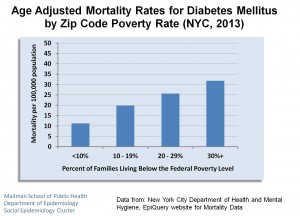| Background: Neighborhood conditions influence health, well being and individual’s economic chances for the future. In NYC cause specific mortality rates are consistently higher in poorer as compared wealthier neighborhood (see Info-Graphix section).
The NY Times recently reported extensively on a large study showing how neighborhood circumstances affect the chances for achieving upward mobility for children from low income families. Cluster faculty have conducted research showing that neighborhood disadvantage is associated with poorer cognitive development in children, higher body mass index, and smoking-related DNA damage in prostate tissue. |
The Mix: The trials and tribulations of living in disadvantaged inner city neighborhoods has been a perennial theme for ska and reggae artists. As the home to many early performers (Bob Marley, Bunny Wailer, Peter Tosh, Delroy Wilson, and Alton Ellis), life in the tough Trench Town neighborhood of Kingston Jamaica served as the inspiration for many early reggae songs. The troubles in the Brixton neighborhood in London, home to a large Caribbean population that saw major riots in 1981 and 1985, also served as the inspiration for several reggae songs.
The play list kicks off with “007 – Shanty Town” by Desmond Decker, who counterpoints the glamour of urban life depicted in the 007 and Oceans 11 movies with the realities of violence in the shanty towns of Jamaica. Three Bob Marley tracks reflect on life in Trench Town, while Steel Pulse similarly describe life in Handsworth, Birmingham. Songs by by The Clash and Eddie Grant focus on Brixton, while in “Ghost Town”, the Specials describe the urban decline they witnessed while on tour across England. Finally, Dr. Israel sings about life in poor neighborhoods in New York City.
|
Follow Us On:
Subscribe to Blog via Email
Search the site:
-
Recent Posts
- Social support and intimate partner violence in rural Pakistan: a longitudinal investigation of the bi-directional relationship
- Overflowing Disparities: Examining the Availability of Litter Bins in New York City
- In New York City, pandemic policing reproduced familiar patterns of racial disparities
- The COVID-19 Pandemic as a Threat Multiplier for Childhood Health Disparities: Evidence from St. Louis, MO
- Lessons Learned From Dear Pandemic, a Social Media–Based Science Communication Project Targeting the COVID-19 Infodemic
Faculty Publications on:

 PubMed Feed
PubMed Feed- Partner incarceration, maternal substance use, and the mediating role of social support: A longitudinal analysis using the future of families and child wellbeing study
- Establishing registry-based mental health research in Latin America
- Adverse childhood experiences among black sexually minoritized men and Black transgender women in Chicago
- Disadvantaged groups have greater spatial access to pharmacies in New York state
- Direct potable reuse and birth defects prevalence in Texas: An augmented synthetic control method analysis of data from a population-based birth defects registry
- Screening mammography frequency following dense breast notification among a predominantly Hispanic/Latina screening cohort
- Neighborhood violent crime exposure is associated with PrEP non-use among black sexually minoritized men and transgender women: A GPS Study
- Police Harassment and Psychiatric, Sexual, and Substance Use Risk Among Black Sexual Minority Men and Black Transgender Women in the HIV Prevention Trials 061 Cohort
- Interstate Highway Connections and Traced Gun Transfers Between the 48 Contiguous United States
- Population Neuroscience: Understanding Concepts of Generalizability and Transportability and Their Application to Improving the Public's Health

